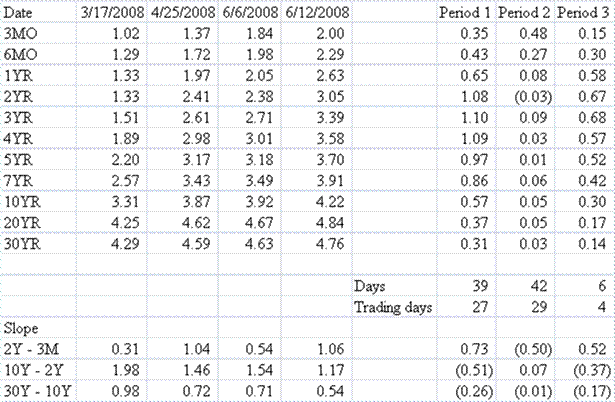Fannie, Freddie, and the Financing Methods of Last Resort
Ugh.? I’m still not home yet, but after my recent 48-hour news blackout, the news on Fannie and Freddie is pretty amazing.? Now, I would not be so certain that an interpretation of SFAS 140 would force Fannie or Freddie to raise capital — GAAP accounting often has little to do with regulatory capital rules.? Only if OFHEO decides to mimic the treatment in GAAP would it force capital-raising, absent any net worth covenants on their debt that might be poorly written.
All that said, the problems with Fannie and Freddie are not primarily accounting-driven, but are being driven by diminishing housing prices, which erodes their margin of safety on their lending and loan guarantees, and diminishes the value of the mortgage insurance that they rely on for some of their business.? Writedowns from these items are what hurt.? It is likely that Fannie and Freddie need to raise capital, but the great questions are how much is needed, and how much can the market stomach?
At times like this, I run through my pecking order of the “financing methods of last resort.”
- Have you maxed out trust preferred obligations? Other subordinated debt?
- Have you maxed out preferred stock?
- Have you issued convertible debt to monetize volatility?
- Have you diluted your equity through secondary IPOs, rights offerings, PIPEs, and/or deals with strategic investors?
- Have you sounded out investors in your corporate bonds about debt-for equity swaps?
- And, unique to Fannie and Freddie, have you asked the US government for a capital infusion or a debt guarantee?
All of these financing methods carry a cost.? (And, as with most situations like this — if it were done, best it should be done quickly.? Delay usually means that cost of financing rises.)? Most of the cost is dilution to existing shareholders, whether common or preferred.? The debt guarantee, or investment by the government has costs for the US taxpayer, which I would rather not see.
Clearly, Fannie and Freddie have room to raise more capital, but the room is not unlimited.? As the Financial Guarantors found, when your stock price gets too low, the jig is up.? You can only raise so much capital relative to the size of your current market capitalization before the market chokes.? After all, most capital raising requires a discount to current price levels, and somehow the diluted value of the equity needs to represent a premium price where new capital gets put in.
In short: it’s tough to get new investors to pay for past losses.? Capitalize a new company?? Could be done, and has already happened with the Financial Guarantors, which has largely sealed the fate of the tarnished incumbents.? That said, why would the US government want a competitor to Fannie or Freddie, aside from GNMA?
As for the US Government, perhaps this all waits for a new President and Congress to act.? Personally, I think that any help extended to Fannie or Freddie should have strings attached.? Investments, or debt guarantees should allow the US government to profit if things turn around.? Other things to explore: only guaranteeing new liabilities, or, expanding the role of GNMA, which is a full-faith-and-credit of the US Government lender.
The one thing I don’t want to see is a bailout that benefits the shareholders of Fannie or Freddie.? They have long had private profits with many public subsidies for years.? Now it is time for the shareholders to bear the losses; let public money only step in to keep senior obligations whole, if it steps in at all.
(Note: these are my private opinions, and not those of my employer.)





Here’s the way I see the obligation to send capital to the subsidiaries: